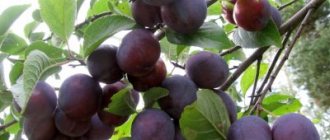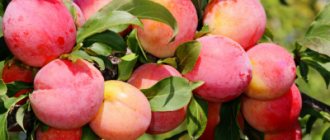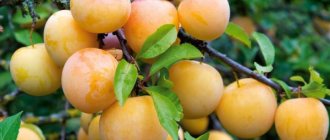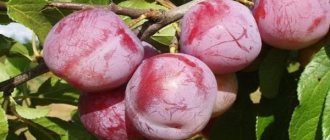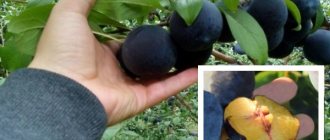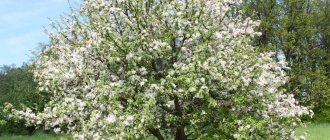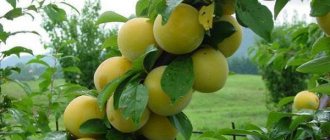Meet the decorative plum with red leaves
When choosing the first trees for their garden, most gardeners do not think about their appearance - the main role is played by tasty fruits. However, over time, the need for beauty arises - and then the decorative red-leaved plum comes to the rescue.
The leaves of the ornamental plum are not green, like most trees, but a rich red-violet color. Therefore, in the garden the plant acts as a bright accent. If a decorative plum with red leaves is chosen to be tall and spreading, then it stands out against the background of other trees, and if it is squat and short, it can border them or serve as a hedge.
Subtleties of use
Cherry plum has a lot of positive qualities, which allows it to be used in various areas of life. It is actively used in medicine, cosmetology and cooking.
The use of cherry plum for medicinal purposes is due to the fact that the fruits contain substances that have a beneficial effect on the human body. The high potassium content helps prevent arrhythmia, strengthen the heart muscle and get rid of excess fluid.
Cherry plum is often consumed by people prone to depression. It is believed that it relaxes and calms the central nervous system, which eliminates the occurrence of stress.
Traditional medicine actively uses cherry plum fruits to treat headaches. To reduce blood pressure, it is recommended to eat about 300 g of fruit.
Cherry plum contains a minimal amount of sugar, so it is recommended to be consumed by people who suffer from diabetes. For the same reason, it is recommended to use it to normalize metabolic processes.
Read more: How to name a rabbit names for rabbits girls and boys
Cherry plum has found wide application in cosmetology due to the rejuvenating properties of the crop. All kinds of masks are made from the fruits of the plant, which help get rid of oily sheen. To create a mask, you need to crush the pulp of 2 fruits, fill it with clean warm water, and leave it overnight. Once the mixture has infused, it can be applied to problem areas of the skin.
In order to rejuvenate the skin, a scrub is made from cherry plum seeds and pulp, which is applied with massaging movements for 15-20 minutes. The same mixture helps fight acne.
Cherry plum fruits have a unique taste and aroma, which is why they are most often used in cooking. From cherry plum you can make wine, jam, marmalade, jam, compote. It is also good that the fruits will retain their original properties even when dried or canned.
Reviews from Caucasian gardeners say that even lavash can be made from cherry plum pulp. This dish is endowed with nutritional and dietary properties, which prevents the formation of scurvy. In addition, this pita bread has a long shelf life.
Line of hybrids “Russian plum”
Particularly popular in the middle zone are varieties of decorative Russian plums, obtained from crossing southern cherry plums with Ussuri or Chinese plums.
Scarlet Sails
The red-leaved plum of this variety is a tree up to 4 - 5 m in height, with a thinned but spreading crown, with large leaves of a rich red color. The plum, with red leaves and dark pink flowers, bears fruit in mid-August. Scarlet sails have a dark crimson color and average weight - each fruit weighs about 25 g.
Among the advantages of Scarlet Sails are high resistance to negative temperatures and drought, and low susceptibility to fungal diseases. The tree produces abundant harvests and bears fruit every year, but is classified as self-sterile. For Scarlet Sails, Chinese plum varieties Skoroplodnaya and Krasny Shar, as well as cherry plum Dynaya can become pollinators.
Lama
This decorative variety of Russian plum is distinguished by its small size - 1.3 - 2 m. The crown is round-flat, thick, the leaves are dark red throughout the summer period. Plum with pink flowers produces large raspberry fruits, each of which can weigh up to 40 g.
The red-leaved Lama variety was bred specifically for cultivation in the middle zone, so it can easily tolerate frosts down to -35 degrees. The tree's shoots are not afraid of light spring frosts; the variety has increased resistance to pests and diseases.
Llama is a self-fertile ornamental plum, so pollinators are required for high annual yields. Chinese plums and cherry plums with flowering in mid-May are well suited for this variety - for example, Vitba, Mara and Asaloda.
Early
Russian plum Early is a large tree up to 7 m in height with a rounded crown, large red leaves with serrated edges and a brown underside of the leaf. It has equally good resistance to frost, diseases and pests, and produces abundant harvests of dark red fruits.
The tree, like most plum varieties, is self-sterile, and therefore requires pollinators, for which cherry plums and Chinese plums with early flowering are ideal.
Nigra
Another red-leaved ornamental variety is Nigra, a low tree with an oval crown. Young leaves are ruby in color, while mature leaves are dark purple. The red-leaved plum blooms with pink flowers in late April or early May, even before the foliage appears on the branches. At the end of August it bears dark red round fruits.
It tolerates frosts below - 30 degrees and summer drought, does not break in the wind, and rarely suffers from diseases typical of fruit trees. The pollinator for the variety can be the Eurasia plum or the domestic Hungarian plum.
Preparation and planting
Since Pissardi is an unpretentious variety, you don’t need to put in a lot of effort for its planting and subsequent care - simple basics are enough, thanks to which high-quality growth and a rich, stable harvest will be ensured.
We recommend that you additionally read the article on how to plant and grow plum trees.
Place and dates
Pissardi is a very sun- and heat-loving plant. Plant trees on the south side of the garden, away from strong winds and drafts, and so that other trees do not cover this plum tree. Be sure to measure the groundwater level - its depth should not exceed 1.5 meters to the bottom of the hole, since Pissardi does not like excess moisture. If this cannot be avoided, then use expanded clay drainage.
Plant trees before the buds swell in the spring, this will give the plant a chance to take root in the soil before the onset of cold weather. But this does not mean that autumn is not suitable for planting. September is considered the best option, since the cuttings will also have time to adapt to environmental conditions.
Neighborhood of cultures
This variety is not able to grow too close to other plants, as it loves solitude and space around itself. Make sure that the tree is not surrounded by unfriendly neighbors. Only at a distance of 5 meters you can plant the following crops:
- berry bushes;
- evergreen tree options;
- apple trees
You cannot plant next to:
- red leaf raspberries;
- pear.
Selection and preparation of seedlings
Planting material of the variety is divided into self-rooted and grafted. When choosing between open and closed roots, choose the first option, as they are more developed and can take root and grow better.
Despite the fact that even large-sized ones (seedlings 5 years old and older) can be sold in nurseries, you should not rush to purchase them in the hope that this way you can get a harvest faster. A common occurrence is cut off roots in seedlings of this age, which indicates that they will take root for another couple of years and during this time younger seedlings will be able to catch up with them and overtake them in development.
When choosing a seedling, consider the following points:
- Pay attention to the level of development of the root system. Plums that are 1-2 years old should have 3 to 5 main roots 25-30 cm long.
- The best choice of planting material occurs in the fall. If the seedlings were purchased in early autumn, then plant them immediately, without delaying until spring, and if in late autumn, then dig them in.
Boarding instructions
Planting a seedling does not require large investments or resources. You only need to have a standard set of tools and materials:
- shovel for holes;
- soil disintegrant;
- fertilizers;
- water;
- soft rope;
- a peg to tie up the cutting.
The landing process occurs in the following order:
- Prepare a hole measuring 50x70 cm (do this 2 weeks before planting), fill it with a fertile layer of soil that has already been mixed with compost and leave it in this state for 2 weeks.
- Install the landing stake.
- Place the seedling on the north side of the stake.
- Straighten the roots and place them in the hole so that the root collar is at a distance of 3-5 cm from the ground level, after which the roots can be covered with soil.
- Compact the ground.
- After completing the planting process, tie the plum to a stake, mulch the ground and water well.
Plum splayed
The spreading plum belongs to the category of red-leaved trees of tall and medium height with abundant and rapid fruiting - the first harvests are harvested from it already 2 years after planting. As a rule, plum varieties are intended for growing in warm climates.
Hesey
A bush variety of red-leaved plum called Hesei produces regular green foliage at first - but then the leaves turn purple, with pink or cream edges. The variety blooms with white flowers at the end of April, before the leaves bloom or simultaneously with it. Bears sweet and sour small red fruits.
The variety is characterized by low frost resistance and tolerates negative temperatures only up to – 28 degrees. Among the diseases that remain dangerous for him are black or holey spots. To obtain fruits, it is necessary to plant splayed plums with similar flowering periods nearby.
Pissardi
An Iranian plum variety up to 6 m tall with dark purple leaves and red shoots. Pissardi is an ornamental plum with pink flowers that blooms in early spring before the leaves bloom. In August it produces abundant pink fruits, provided that other varieties of spreading red-leaved plum have been planted nearby for pollination and bloom at the end of April.
The frost resistance of the Pissardi variety is not very high - from -20 to -28 degrees. But the tree is highly resistant to disease.
Cystene
This ornamental variety was obtained by breeding sand cherry and red-leaved Pissardi plum. The dwarf plant grows only up to 2 m, and at the same time it grows very slowly, so Cysten plum is often classified as a shrub with a columnar crown. The leaves are elongated, rounded and toothed, dark purple on the underside and red-violet on top.
The red-leaved Cystena blooms in early spring with white flowers with a red core, and in late summer it bears fruit - dark purple small drupes. If you plant other varieties of short red-leaved plums nearby, Cystena will delight you with abundant harvests.
The frost resistance of the variety is low, so it is not recommended to breed Cystena in cold regions. But the variety is quite resistant to diseases and pests.
Features of agricultural technology
Valuable advice for beginning gardeners: you should only take seedlings that are grown in the same region where you plan to plant. Otherwise, the young animals may not take root.
The spreading plum is very sun-loving. The more heat and light it receives, the larger and sweeter the harvest. The optimal place for its cultivation and reproduction is the southern or southwestern part of the site. It is advisable to hide the plant from the winds near a wall.
Cherry plum loves moist, fertile loamy soil with a good drainage system. The root of the tree goes 40 cm deep, so close groundwater is undesirable, maximum 1 m. If the site does not allow this condition to be met, an artificial hill can be created.
It is customary to dig holes for planting 2 m apart from each other. The depth and diameter of each must be at least 60 cm. When the holes are ready, they need to be filled with a nutrient mixture. To prepare it, add superphosphate and potassium sulfate 300 and 40 grams, respectively, to the ground.
A mound is formed in the hole and the roots of the tree are laid on it. The seedling must be fixed so that the root collar is level with the surface of the earth. Then they cover everything with the remaining fertile mixture.
It is important to stick to the basic rules. The substrate should easily allow air and moisture to pass through. That is why clay soil must be diluted with sand, and sandy soil with turf.
Plum splayed is an adherent of neutral soil. If the soil does not meet this requirement, some adjustments need to be made. It is worth adding chalk or limestone to acidic soil, and gypsum to alkaline soil. Not all summer residents know what the acidity of the soil is on their site. To clarify the picture, you can use special indicators. Similar devices are available in any garden store.
Particularly painstaking summer residents grow cherry plums from seeds. This is quite possible, but troublesome. A more common method is grafting onto another crop. The procedure is carried out in the spring. Use cuttings on which the buds have not yet bloomed.
An excellent result is obtained by crossing cherry plums with some variety of plum. You can get several benefits at once:
- Several varieties can be grafted onto 1 tree; this type of group cultivation will simplify pollination and significantly save space on the site;
- if you graft a cutting onto an adult plant in the spring, then in a year you can expect the first harvest;
- unusual appearance of the tree, when there are fruits of different colors on the branches;
- Thanks to the properties of the plum, on which it is customary to graft cherry plum, the latter’s winter hardiness increases significantly.
The optimal result can be achieved if plum varieties Nigra, Kuban Comet and Traveler are grafted onto one tree. It is these varieties that are able to self-pollinate each other well.
Nigra plum variety
Don't forget about feeding. The plum tree will be grateful if you fertilize the soil three times a year (after the snow melts, at the time of fruit formation and in the middle of summer). It is best to follow a certain sequence. In spring, it is recommended to add minerals and ammonium sulfate to the soil. For acidic soil, calcium ammonium nitrate is indicated. It is impossible to do without organic matter. Manure and compost remain indispensable. During summer fertilizing, phosphorus-potassium fertilizers are well suited.
Purple-leaved decorative plum: photo + description
The decorative purple-leaved plum is ideal for decorating the garden - a shrub reaching 1.5 in height, with elongated lanceolate leaves. At the very beginning, the foliage of the plum bush is dark red, then as it matures it can turn to a dark brown shade. The purple-leaved ornamental plum produces white or light pink flowers at the same time as its foliage appears, and bears a harvest of dark red fruit in late September.
It is best to plant plums in windless, sunny places, in well-drained, slightly alkaline or acidified soil. The shrub has high winter hardiness.
What can you cook?
There are quite a few recipes in which the main ingredient is cherry plum. And the culinary sphere is not limited to preparations for the winter.
Below are some unusual recipes using cherry plum fruits.
To implement this recipe you need to prepare:
- 1 kg cherry plum;
- a head of garlic;
- 1 tablespoon of herbs;
- a bunch of dill;
- salt;
- sugar;
- a pinch of red pepper.
Clean fruits are poured with water and placed on low heat. After the mixture boils, the water is poured into a separate container, and the cherry plum is pitted and crushed using a meat grinder. Pour a mug of drained water into the resulting porridge and set the mixture to simmer over low heat. After an hour, finely chopped herbs and garlic are added to the finished puree and seasoned with spices.
Read more: Description of the apricot variety “Manitoba” - Sam-Village
Manna
To make this flavorful pie, you will need:
- 200 ml semolina;
- 200 ml kefir;
- 120 g sugar;
- 2 eggs;
- 2 tablespoons baking powder;
- 2 teaspoons cinnamon;
- 300 g cherry plum.
Semolina is mixed with sugar and kefir and allowed to brew for half an hour. Then eggs, cinnamon and baking powder are added to the mixture. The resulting dough is poured onto a baking sheet, and chopped pieces of cherry plum are laid out on top. Everything is generously sprinkled with sugar and placed in the oven, preheated to 180, for 1 hour.
Syrniki
For this recipe you need to prepare:
- 200 g cherry plum;
- 500 g cottage cheese;
- 80 g sugar;
- 80 g flour;
- 2 eggs;
- 50 ml vegetable oil;
- a pinch of salt;
- half a teaspoon of baking powder;
- a little vanilla.
Mix cottage cheese and sugar in a deep bowl. Then eggs are beaten into the resulting slurry, flour, sugar, baking powder are added and everything is mixed. The cherry plum is separated from the seeds and finely chopped, after which it is added to the dough. Pour oil into a heated frying pan and lay out the formed cheesecakes.
For the recipe for cherry plum sauce, watch the following video.
Red-leaved plum variety "Hollywood"
One of the most popular red-leaved varieties is Hollywood. The plum tree reaches several meters in height and is distinguished by a spreading, sparse crown formed by dark red shoots and red leaves. Hollywood blooms with white flowers. It is not only the appearance of the plant that is attractive, which can be appreciated from the photo of a plum with red leaves. The variety also bears purple-red tasty fruits in mid-August.
Hollywood enters the harvest period 5 years after planting and produces juicy and sweet fruits. The best pollinators for a self-sterile variety will be the collective farm Renklod and the Mirnaya plum.
Important! The Hollywood variety has good winter hardiness, tolerates lack of moisture well and is not susceptible to fungal diseases.
ASALODA
The tree is fast growing, with a rounded, raised crown.
Biological features: Self-sterile. The best pollinators are varieties Mara and Vitba.
The fruits are medium in size (average weight - 25 g), round in shape, dark red with numerous large, clearly visible subcutaneous dots. The stone is small, fused with the pulp.
The pulp is yellow, very juicy, pleasant sweet taste, with a strong aroma, tasting score - 4.2 points.
Consumption period: first half of August.
Advantage: The variety is winter-hardy, productive, and highly resistant to cluster blight.
CINDERELLA
The tree is low-growing, with a round-oval sparse crown.
Biological features: Partially self-fertile.
The fruits are large (average weight 30 g), oval. The skin is smooth. Color ranges from dark pink to burgundy. The stone is small, elongated, and separated from the pulp. The pulp is burgundy, very juicy, sweet taste, with a very pleasant aroma.
Consumption period: first ten days of August.
Advantage: The variety is winter-hardy, early-fruiting and high-yielding.
The tree is of medium vigor, the crown is rounded-pyramidal, of medium density.
Biological features: Self-sterile. The best pollinators are the Mara and Asaloda varieties.
The fruits are large (average weight - 36 g), round. The abdominal suture is deep. The main and top color of the skin is yellow. The stone is small and easily separated from the pulp. The pulp is yellow, tender, very juicy, with a caramel aroma. The taste is sweet and sour. Consumption period: end of July – beginning of August.
Advantage: The variety is winter-hardy, productive, resistant to cluster blight, caramel aroma.
PRECIOUS
The tree is fast-growing, vigorous, with a rounded-spreading, medium-density or sparse crown.
Biological features: Self-sterile.
The fruits are medium size, 25-28 g, round. The ventral suture is moderately pronounced. The skin is bright red with a faint waxy coating. The skin is thick and dense. The peduncle is short. The bone is large.
The pulp is juicy, yellow, aromatic. The taste is sweet and sour, good.
Date of consumption: August.
Advantage: The variety is winter-hardy, high-yielding. Relatively resistant to diseases. Fruits of universal use.
The nuances of growing ornamental plums
Plum varieties with burgundy leaves can be quite different from each other - it is quite difficult to formulate uniform rules of care for them. But general nuances still exist.
- Decorative plums do not like overly waterlogged soil; it is better to plant them in soil with a neutral acidity level.
- Before planting in the seedling hole, it is necessary to add organic fertilizers - humus and superphosphate, which will nourish the plant in the first 3 years of life.
- After entering the harvest season, red-leaved plums are regularly fed with mineral fertilizers and organic matter. In the spring it is necessary to apply nitrogen fertilizers, in the summer - a solution of mullein and potassium. In autumn, the soil around trees and shrubs is dug up and also flavored with humus.
- Decorative plums should be watered as needed - the soil should not be allowed to dry out. Usually, once every 1–2 months, with moderate precipitation, 4–5 buckets of water are added under the roots.
Decorative plum with red leaves necessarily needs pruning, which is carried out annually. Red-leaved trees and especially shrubs tolerate pruning well; their crowns are given a round, sparse or vase-like shape.
Attention! Decorative red-leaved plums also require sanitary pruning - timely removal of all dry and weakened parts. Otherwise, the plant may suffer from diseases and pests.
Further care
Plum is easy to care for. It is important to follow just a few points:
Watering and fertilizing
Watering a plum
Plum Orlovskaya Dream
Despite the high level of drought resistance in the red-leaved plum, full irrigation will not be superfluous. It is carried out weekly if possible. 40-60 liters of warm, settled water should be poured onto each tree.
In the first year of cultivation, a young seedling can do without fertilizing. Fertilizers begin to be applied in the second year of the plant’s life. So, in the spring, purple plum needs sodium humate and potassium fertilizers. In autumn it is important to add humus.
Important! For 1 m² of plot, half a bucket of organic fertilizer is used.
In the spring, nitrogen fertilizers are usually applied to the Pissardi plum tree, which makes it possible to increase and accelerate the process of growth of annual growth. A normal level of fruiting in the summer can be ensured by phosphorus fertilizing. To help the plant survive the winter better, a certain amount of potassium is added under the tree in the fall.
Plum feeding
Soil care
The root system of the Pissardi plum lies predominantly in the upper soil layers, as a result of which it needs a constant flow of oxygen and moisture. This can be achieved by regularly loosening the soil. This is usually done after the next irrigation. This procedure allows you to get rid of weeds that can cause serious harm to the crop, especially in the first years of cultivation.
After each watering and loosening, mulching should be carried out. This procedure is additionally carried out twice more during the growing season. The first is carried out in the spring in order to accelerate the warming of the soil and the beginning of its full functioning. In this case, compost or rotted manure is used. The next additional mulching is repeated in the fall, when the first frosts begin. It will protect the root system from freezing.
Trimming
Pruning plum
Pissardi is good at both formative and sanitary pruning. The first is carried out to give the plant a decorative appearance according to the appropriate scheme, the second - to remove diseased, dried, severely injured stems. Both prunings are carried out in the spring, but diseased shoots can be cut out at any time of the year.
Note! After giving the plant a decorative shape, you need to promptly remove young growth, which will spoil the appearance.
Preparing for winter
Pissardi plum does not have sufficient winter hardiness and frost resistance, so it is very important to prepare the plant for the winter period. This can mainly be achieved through abundant irrigation and mulch. The tree trunk is covered with straw, peat or special covering material, which can be purchased at specialized garden stores.
Plum shelter for the winter


